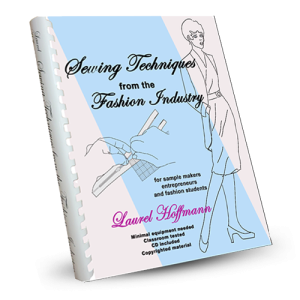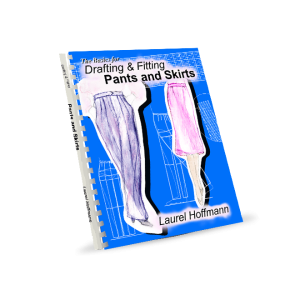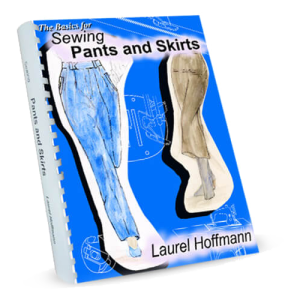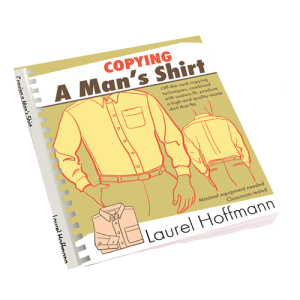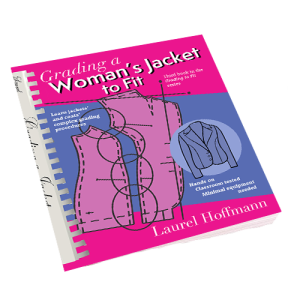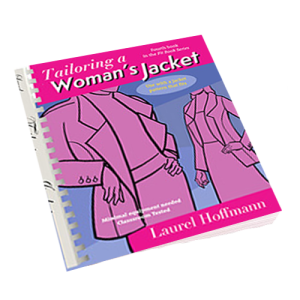The Problem:
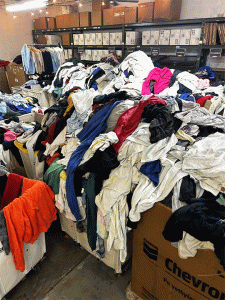
Sandra Rossi comments about the disposal of used clothing
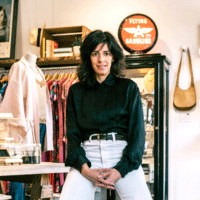
- I and one of my staff will spend full days in textile recycling centers wading through the discarded garments (we love it) that have been sorted for us resellers. FYI – only 15% of your donated garment stay at the donation center (there’s too much)- before many of them are sold off to textile recyclers who sort and sell off the items Global South.
- With an ever-increasing number of low-quality discarded garments -the truth is much of what is sold off ends up in the landfills that are overflowing (like that of Atacama in Chile or in the Kantamanto market in Africa). The above quotes are excerpted from Sandra Rossi’s post on LinkedIn
Sandra Rossi, a twenty year veteran for leading lifestyle brands and retailers, left corporate for community. A purpose driven, feminist principled small business owner who is driving change for conscious consumerism and sustainable business.
Industry’s Efforts Toward Sustainability
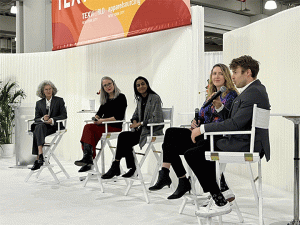
Wednesday, January 24, 2024, the Material Innovation Initiative seminar was presented at the TexWorld NYC trade show in the Javits Center in NYC. This was without question, the very best TexWorld trade show seminar I have ever attended.
The panelists talked at length about the work they are doing to produce sustainable fibers.
The panelists included (in the order seen in the photo) Thomasine Dolan, moderator, at ; Julie A. Willoughby, PhD, Saloni Gupta, at , developer of Bio-based & biodegradable polyester; Jen Keane, Co-founder and CEO of Modern Synthesis; and Martin Stübler,
Jen Keane, Co-founder, CEO of Modern Synthesis recently emailed me these quotes for inclusion in this blog post:
- The key to making the transition to a more sustainable industry is scale. What we’ve been doing is looking at how we can use existing infrastructure and machinery to make really cool materials that are animal-and-plastic-free, reducing the industry’s reliance on fossil fuel inputs.
- Cellulose absorbs color really well. It is possible to engineer the material with synthetic biology, so the bacteria produces natural black pigment [melanin] as it is growing and dyes itself black. This is the tip of the iceberg of what can be accomplished with biology.
- Relationships between innovators and brands are critical when building an ecosystem for next gen materials. When you introduce something that’s completely new to these brands, a lot of the time, there isn’t the structure for embedding these new technologies into collections.
Martin Stübler commented that plant fibers are as diverse as plants are. He said that when starting his company he had found the right partners who had industrial equipment. He added that bio flux is being produced in sever different styles of fur. Asked about testing, he replied, We can only improve what we can test.
Julie A. Willoughby said,
- We can engineer proteins that mimic nature. Structural proteins, inspired by the DNA found in nature, have multiple performance properties such as self-healing and elasticity. Tandem Repeat Technologies has special know-how to spin protein-containing fibers with the right economics.
- The power of the Brand cannot be underestimated. Early adapters of new technologies and materials are the trailblazers in the industry. When the Brand partners with entrepreneurs and embraces early-stage technology, they are moving us forward.
- She remarked that we need all of us to work together. That we only win if we all win.
Saloni Gupta said,
-
New materials may need new dyes, existing colorants are set up for traditional materials that have been used for decades. There are challenges at each step of scaling new material innovation and bringing it to mainstream commercialization. It’s only a little time before environmental policies and regulations like those being evolved in the EU come to the US.
-
Manufacturing is the biggest cost and needs the most investment in infrastructure. For a startup having external mill partners is a huge benefit so we don’t have to take the burden of investing in equipment to spin the yarn or weave the fabric. We can also test production processes in real-world settings early to ensure that this can meet industrial needs as we scale.
-
By 2030, It is projected that the fashion industry will account for 1.27 billion metric tons of carbon dioxide emissions if no drastic changes are taken.**
-
This is not only an environmental problem but also an economical one. World leading brands won’t meet sustainability regulations and target goals if they don’t invest in new materials now, they will face shortages and business will fall behind. So we created Kintra, a new and proprietary synthetic fiber that is 100% bio-based, biodegradable, and made on standard equipment to help the industry meet their sustainability efforts.
-
By 2030, It is projected that the fashion industry will account for 1.27 billion metric tons of carbon dioxide emissions if no drastic changes are taken.* This is not only an environmental problem but also an economical one. World leading brands won’t meet sustainability regulations and target goals if they don’t invest in new materials now, they will face shortages and business will fall behind. So we created Kintra, a new and proprietary synthetic fiber that is 100% bio-based, biodegradable, and made on standard equipment to help the industry meet their sustainability efforts.
For information on how you as an individual can help with sustainability, visit my previous post, Responsible Consumer Sustainability.
Comments are welcome.
Thanks for reading,
Laurel
LaurelHoffmann-YouTube
https://laurelhoffmann.com/
https://www.facebook.com/CFashionEdu
https://www.linkedin.com/in/laurelhoffmann/
https://www.instagram.com/laurelhoffmann4015/
RSS Feed: https://laurelhoffmann.com/blog/
https://www.ravelry.com/projects/LaurelHoffmann
https://www.yelp.com/biz/laurel-hoffmann-oreland
https://www.thumbtack.com/pa/philadelphia/drawing-lessons/fashion-drafting-sewing-books-classes
e-mail
Phone: 215 884 7065
